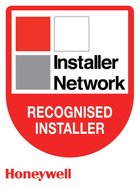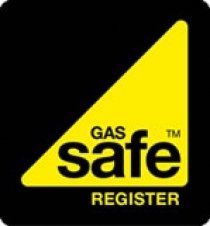Our Services

Boiler Installations
We install every type of boiler, combination, regular or system.
Read More
We are Manufacturer trained by Vaillant, Vissemann and Glowworm, and can offer extended warranties of up to 10 years on these boilers.
Please call or email us to arrange a free quote to discuss upgrading to a professionally installed energy efficiency boiler
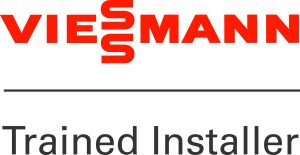
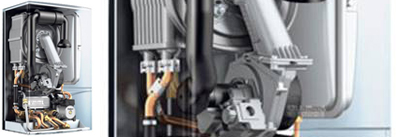
Boiler Service and Repairs
Read More
We attend regular manufacturer installer training programmes to ensure we have the knowledge to quickly diagnose boiler or heating control faults.
We carry a range of spares to ensure that any repair is carried out promptly.
Please call to arrange your boiler service or repair.
01202 476 849
07704 87 33 26

Gas
Read More
- Central Heating Boilers. Combi, System, Regular.Cooking Appliances, hobs, cookers, stoves,range cookers, Fires & Wall Heaters, decorative fires, real effect fires.
- We can carry out new gas pipework installations, and alterations.
- We can safely cap off unwanted gas feeds, for instance to an unwanted gas fire in the lounge.
- All our gas work is to the highest standard and complies to the requirements from the Gas Safe register.
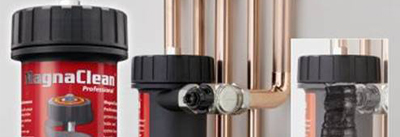
Magna Clean Installations
Read More
Installed in more than three million homes throughout Europe, ADEY’s MagnaClean® filters collect the damaging black iron oxide sludge that builds-up in heating systems. In doing so, MagnaClean helps reduce heating bills and maintenance costs protecting boilers for longer.
Having invented the Queen’s Award winning MagnaClean filter, ADEY produces an extensive range of filters for all types and sizes of properties and heating systems along with a comprehensive range of premium chemicals.
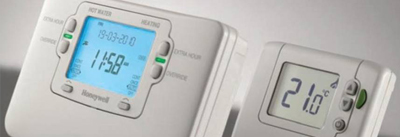
Smart Thermostats and Programmers
- We install , fault find and replace all types of central heating controls.
Read More
- We can install a new room thermostat,as a replacement or a new installation both wired or wireless.
- We install new or replacement hot water tank thermostats, to control your hot water temperature
- We install new or replacement central heating and hotwater programmers, and all types of time switches
- We install new or replacement all heating control valves both 2 and 3 port.
- We install new and fault find internet enabled control systems
- We diagnose faults on all of these controls.
- We are recognised Honeywell heating control experts.
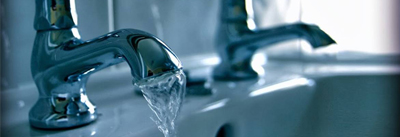
Plumbing
Read More
- Radiator Replacement
- Radiator Valves
- Thermostats (Installed, Replaced)
- Burst pipes
- Taps Added
- Outside Taps
- Ball valves
- Hot water cylinders
- Cold water storage
- Washing machines
- Dishwashers and fridges connected

Heating controls
Read More
Having the correct controls will help with comfort levels at a reduced cost. We are experienced and qualified in all aspects of heating and hotwater controls installation, diagnosis, and repair.
Modern gas central heating systems are safe, controllable and efficient to run but can cause confusion as they have a number of controls that you may not fully understand.
Using heating controls properly can
- Improve the comfort of your home
- Reduce the energy used and your fuel bills
- Avoid the risk of condensation dampness
- To get the best out of your system, you should follow the manufacturers instructions. If you have mislaid the instruction booklet for your systems, most manufacturers can provide a replacement.
Why have controls on a gas central heating system?
- Boiler (which can be a condensing, condensing combi, conventional or conventional combi model)
- Hot water tank for systems without a combi boiler
- Room thermostat
- Radiators
- Thermostatic radiator controls
- Programmer
- The Boiler
Boiler
If your boiler is a ‘combi’ boiler then the water is heated instantaneously when the hot water taps are switched on.
The thermostat on the boiler controls the temperature of the water circulating around the system. Please refer to the manufacturer’s instructions for the optimum setting of the thermostat.
Hot Water Tank
Most hot water cylinders have a thermostat; this is recommended to be set at 55.C. To retain as much heat as possible the cylinder should have 80mm of insulation.
Radiators
Radiators are most commonly used in “wet” (uses water) central heating systems. The water is heated by the boiler and travels through the radiators, giving out heat.
Thermostatic Radiator Valves (TRVs)
Room Thermostat
ThermostatThis is usually found in the living room or hallway and is recommended to be set at 21°C. The room thermostat will respond to the temperature in the room where it is situated. When the room is warm enough it sends a signal to the central heating pump to stop heating the radiators until the temperature drops below the set level. At this point they will come back on again.
Programmer or Timer
Heating timerSo that the house is warm when you wake up, set the heating to come on approximately 30 minutes before you get up and then in the evening set the heating to turn off about 1 hour before you go to bed. This will allow the house to warm up in the morning and cool down slightly at night.
There is a variety of programmers for operating central heating (CH) and hot water (HW). The majority have the following controls:-
- ON/CONSTANT -HW/CH is on 24 hours each day.
- OFF – the HW/CH is completely off.
- ONCE – the HW/CH comes on at the first “ON” time selected and turns off at the second “OFF” time selected.
- TWICE/AUTO – the HW/CH comes on for the 2 selected time periods.
- HOT WATER ONLY – the heating system will not operate
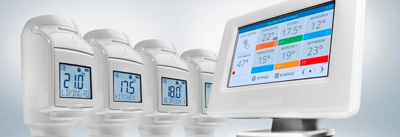
Honeywell Evohome
Read More
Why buy Honeywell evohome?
What are the benefits of Honeywell evohome?
Not only does evohome allow you to control your heating more easily, it can also save you money due to it’s high efficiency levels. Upgrading your basic timer and thermostat control to evohome smart zoning could deliver as much as 40% savings on heating your home!
What are the features of Total Connect Comfort?
- Control your heating from anywhere using mobile devices
- Manage multiple thermostats and locations
- View and change temperature settings and heating schedule
- Activate quick actions and system modes
See the current outdoor temperature and 5-day forecast - Get connection alerts
- Automatic software updates
Sync your Heating and Security
As well as managing heating, you can take control of your home security too – from anywhere. If you have both evohome heating products and evohome security products you have the option of syncing both. This is particularly helpful when leaving the home as simply arming your system will turn of the heating. Helping you save on your energy bills.
Stored Hot Water Control
OpenTherm Boiler Control
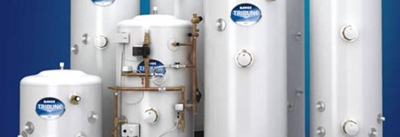
Hot water Cylinder
Most homes have a hot water cylinder to help meet their hot water needs. Hot water cylinders will last a very long time and will only need replacing if they leak, or if you are upgrading to a bigger capacity.
Read More
The different types of hot water cylinders
There are two various types of hot water cylinders installed in homes across the UK. They operate to provide hot water to your home with slight differences. Each type has its advantages and disadvantages, and this part of the article describes these. The prices for replacing the hot water cylinder will differ for each type as they are fundamentally different hot water system designs.
Vented hot water cylinder
A vented hot water cylinder system consists of a cold water tank located commonly in the loft which feeds cold water to the cylinder. The cylinder is typically situated in an airing cupboard, with the cold water feed at the bottom of the tank. Heated water rises to the top of the reservoir where it is drawn off for feeding the heating system.
A vent pipe acts as an outlet for air bubbles, and steam should the cylinder overheat and also keeps the cylinder pressure at atmospheric pressure.
- Direct heating – immersion heaters are fitted in the cylinder, and they solely provide the hot water.
- Indirect heating – a coil within the hot water cylinder is fed via the central heating system and heats the water in the cylinder.
The difference between vented and unvented systems
The difference between vented and unvented systems is that there is no water storage tank or vent pipes. Instead, an expansion vessel is connected to the top of the cylinder. The purpose of the expansion vessel is to accommodate expanding water coming from the cylinder.
The following safety devices are necessary for unvented cylinders:
- Primary and secondary thermostats. The main thermostat maintains the temperature of the water below 65 degrees while the secondary switches off the heater or cuts off water supply if the temperature exceeds 90 degrees Celsius.
- At Perrin Heating we can supply and install both vented and unvented types of hot water cylinder
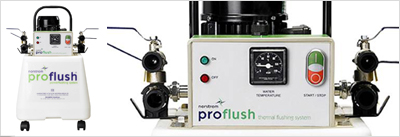
Powerflushing
What Is Powerflushing?
- Powerflushing is a cleansing process designed to rid the central heating system of sludge, rust and corrosive inefficiencies that accumulate over time in most heating systems. In addition to increasing the efficiency of the heating system, the powerflush also serves to protect the main heating plant. Powerflushing should only be administered by a knowledgeable and experienced central heating expert.
- Powerflushing is a proven solution for uneven heat distribution and for remedying the inefficiencies of the central heating system. Many homeowners are unaware that the heat circulation in their home is clogged. Powerflushing is the best way to ensure that the system is circulating properly and not adding pressure to the heating unit.
- Powerflushing is also recommended when new systems are being installed. A new boiler replacing an older boiler is only as effective and efficient as the circulation of the existing piping. Powerflushing is a safe, relatively inexpensive process that will add warmth to the home and reduce energy expenditures at the same time.
Warning Signs That Powerflushing is Needed
Cold radiators – Are some radiators warm while others are cold? The reason for this is rust and sludge that has accumulated in pipes and is preventing heat from circulating to all radiators in the home.
Excessive Noise – Can you hear you boiler overworking? Do you hear air trying to fight through the sludge and rust in pipes? If your central heating system is making unusual noises, the chances are a powerflush is in order.
Discoloured Water – When you bleed your radiators and pipes are you finding the water is discoloured? That is a clear warning sign that the system is in jeopardy and in need of powerflushing. In extreme cases, you might notice that tap water is cloudy.
How Powerflushing Works
Powerflushing is safe if administered by an experienced heating engineer likle Home Cure. The heating engineer will connect a high flow, low pressure pumping unit to the system. The most likely connection point is the circulation pump or the pump head, depending upon the system.
The engineer will add high strength cleaning chemical to the system. These include ingredients to break down sludge crust that inevitably builds on the pipes. A chemical to remove the sludge is also used along with a descaler to break down the limescale. After the initial flush, crust and rust inhibitors are added to the system.
The crust breakers and removers are acid-based cleansers. These will also rid the system of any sand that may have accumulated in the system. When the powerflush is complete, the acid will be washed thoroughly from the system.
Professional powerflushing takes can take a few hours. Most homeowners notice the difference immediately. Please feel free to get an estimate beforehand to find out about time frames and costs.
In the UK today, many residents are concerned about the cost and amount of energy used to heat their homes and businesses. Powerflushing is a great way to reduce energy expenditure, your carbon footprint and most importantly to improve the heat circulation in your home. By removing the sludge and corrosive elements from your central heating system, you are also prolonging the life of your heating plant. Replacing a boiler is one expense nobody wants to incur.
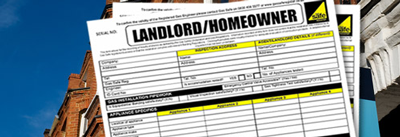
Landlords Certificates & Safety
By law, under the Gas Safety (Installation and Use) Regulations 1998, it’s your responsibility to get a Gas Safety Certificate every twelve months.
Gas Safety Certificate explained
By law, under the Gas Safety (Installation and Use) Regulations 1998, it’s your responsibility to get a Gas Safety Certificate every twelve months. You must get this from a Gas Safe Registered engineer for all pipe work, gas appliances and flues installed at your property.
If you use an agent to manage your property, you need to make sure your contract clearly states in black and white whose responsibility it is to carry out maintenance on gas appliances. You must also keep copies of all the paperwork. You’ll need to keep a record of the safety inspection for two years, and give a copy to all of your tenants within 28 days of the inspection. If your tenants change, they’ll need a copy of the Gas Safety Certificate before they move in. If your contract says the agent is responsible, then the Gas Safety (Installation and Use) Regulations 1998 are passed on to them.
Top tips
- Legally you only have to carry out a gas safety inspection every twelve months, but it’s a good idea to get appliances checked between tenants too. Then you’ll be sure your appliances are in tip-top condition before your new tenants move in.
- Installing a Carbon Monoxide (CO) alarm comes highly recommended – not just by us, but by HSE too. It’s the best way to make sure your tenants are safe from dangers of Carbon Monoxide poisoning. But an alarm should never replace regular maintenance and safety checks.
What you’ll get with a Gas Safety Certificate:
- Your gas appliances will be checked for gas tightness.
- If test points are available, standing and working pressure will be tested.
- Your Gas Safe engineer will check burner pressure and gas rate against the manufacturers data plate.
- Checks will be carried out for the provision of all necessary ventilation.
- Flue flow will be tested to make sure products of combustion are removed.
- All flame failure devices will be checked for satisfactory operation.
- Where appropriate checks will be made for physical stability, presence and effectiveness of stability brackets.
- Investigations for any evidence of unsafe operation will be made and reported.
- Without completing all of the above checks an appliance can not be issued a Gas Safety Certificate.


Perrin Heating
2 Sandy Lane
Christchurch
Dorset
BH23 2NJ
Contact Us
07704 873326
Sat - 8am-12pm
24 HOUR EMERGENCY CALL OUT

